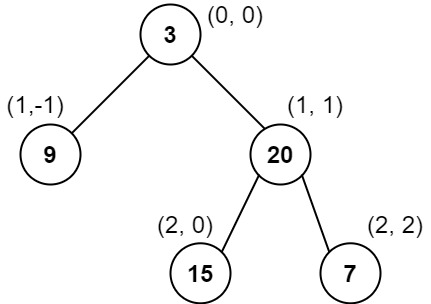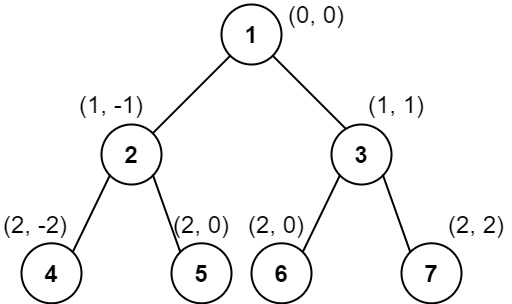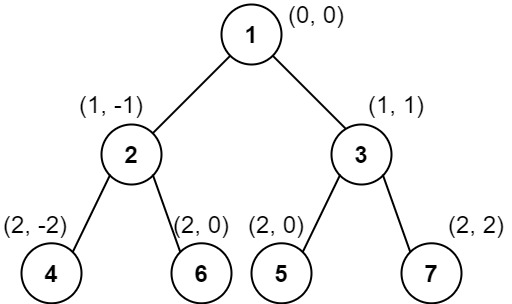Vertical Order Traversal of a Binary Tree
 Chetan Datta
Chetan DattaTable of contents
Problem Statement
Given the root of a binary tree, calculate the vertical order traversal of the binary tree.
For each node at position (row, col), its left and right children will be at positions (row + 1, col - 1) and (row + 1, col + 1) respectively. The root of the tree is at (0, 0).
The vertical order traversal of a binary tree is a list of top-to-bottom orderings for each column index starting from the leftmost column and ending on the rightmost column. There may be multiple nodes in the same row and same column. In such a case, sort these nodes by their values.
Return the vertical order traversal of the binary tree. (link)
Example 1:

Input: root = [3,9,20,null,null,15,7]
Output: [[9],[3,15],[20],[7]]
Explanation:
Column -1: Only node 9 is in this column.
Column 0: Nodes 3 and 15 are in this column in that order from top to bottom.
Column 1: Only node 20 is in this column.
Column 2: Only node 7 is in this column.
Example 2:

Input: root = [1,2,3,4,5,6,7]
Output: [[4],[2],[1,5,6],[3],[7]]
Explanation:
Column -2: Only node 4 is in this column.
Column -1: Only node 2 is in this column.
Column 0: Nodes 1, 5, and 6 are in this column.
1 is at the top, so it comes first.
5 and 6 are at the same position (2, 0), so we order them by their value, 5 before 6.
Column 1: Only node 3 is in this column.
Column 2: Only node 7 is in this column.
Example 3:

Input: root = [1,2,3,4,6,5,7]
Output: [[4],[2],[1,5,6],[3],[7]]
Explanation:
This case is the exact same as example 2, but with nodes 5 and 6 swapped.
Note that the solution remains the same since 5 and 6 are in the same location and should be ordered by their values.
Constraints:
The number of nodes in the tree is in the range
[1, 1000].0 <= Node.val <= 1000
Solution
The idea is simple: for each column, we need to create a list from top to bottom. If any elements are in the same row, we should sort them and then add them directly to the list.

The main idea is to create a list of elements for each column. Since elements might appear in the same row, each column will have a list of rows, and each row will have a list of elements that overlap. This overlapping list will be sorted.
The plan is to build a map that stores the relationship between columns, rows, and sorted lists of elements. After that, we use this map to create the final answer list.
Example:

Time - O(n)
Space - O(n)
DFS Approach
class Solution {
public void buildMap(TreeNode root, Map<Integer, Map<Integer, PriorityQueue<Integer>>> columnMap, int row, int column){
if(root==null){
return;
}
if(!columnMap.containsKey(column)){
columnMap.put(column, new TreeMap<>());
}
if(!columnMap.get(column).containsKey(row)){
columnMap.get(column).put(row, new PriorityQueue<>());
}
columnMap.get(column).get(row).offer(root.val);
buildMap(root.left, columnMap, row+1, column-1);
buildMap(root.right, columnMap, row+1, column+1);
}
public List<List<Integer>> verticalTraversal(TreeNode root) {
Map<Integer, Map<Integer, PriorityQueue<Integer>>> columnMap = new TreeMap<>();
buildMap(root, columnMap, 0, 0);
List<List<Integer>> ans = new ArrayList<>();
for(Map<Integer, PriorityQueue<Integer>> rowMap : columnMap.values()){
List<Integer> verticalList = new ArrayList<>();
for(PriorityQueue<Integer> pq : rowMap.values()){
while(!pq.isEmpty()){
verticalList.add(pq.poll());
}
}
ans.add(verticalList);
}
return ans;
}
}
BFS Approach
class Tuple{
TreeNode node;
int row;
int column;
Tuple(TreeNode node, int row, int column){
this.node = node;
this.row = row;
this.column = column;
}
}
class Solution {
private void buildMap(TreeNode root, Map<Integer, Map<Integer, PriorityQueue<Integer>>> columnMap){
Queue<Tuple> queue = new ArrayDeque<>();
queue.add(new Tuple(root, 0, 0));
while(!queue.isEmpty()){
Tuple tuple = queue.poll();
TreeNode node = tuple.node;
int row = tuple.row;
int column = tuple.column;
if(!columnMap.containsKey(column)){
columnMap.put(column, new TreeMap<>());
}
if(!columnMap.get(column).containsKey(row)){
columnMap.get(column).put(row, new PriorityQueue<>());
}
columnMap.get(column).get(row).offer(node.val);
if(node.left!=null){
queue.add(new Tuple(node.left, row+1, column-1));
}
if(node.right!=null){
queue.add(new Tuple(node.right, row+1, column+1));
}
}
}
public List<List<Integer>> verticalTraversal(TreeNode root) {
Map<Integer, Map<Integer, PriorityQueue<Integer>>> columnMap = new TreeMap<>();
buildMap(root, columnMap);
List<List<Integer>> ans = new ArrayList<>();
for(Map<Integer, PriorityQueue<Integer>> rowMap : columnMap.values()){
List<Integer> verticalList = new ArrayList<>();
for(PriorityQueue<Integer> pq : rowMap.values()){
while(!pq.isEmpty()){
verticalList.add(pq.poll());
}
}
ans.add(verticalList);
}
return ans;
}
}
Subscribe to my newsletter
Read articles from Chetan Datta directly inside your inbox. Subscribe to the newsletter, and don't miss out.
Written by

Chetan Datta
Chetan Datta
I'm someone deeply engrossed in the world of software developement, and I find joy in sharing my thoughts and insights on various topics. You can explore my exclusive content here, where I meticulously document all things tech-related that spark my curiosity. Stay connected for my latest discoveries and observations.